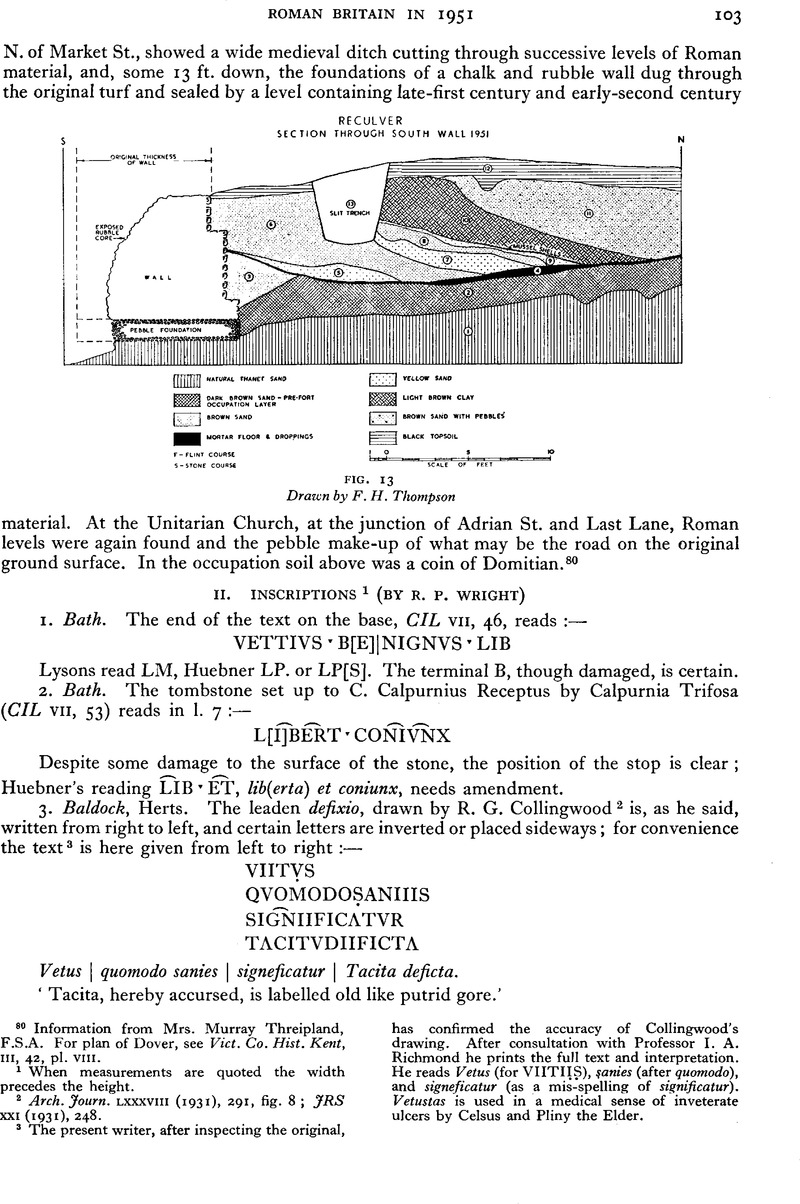No CrossRef data available.
Article contents
Abstract

- Type
- Roman Britain in 1951
- Information
- Copyright
- Copyright © R. P. Wright 1952. Exclusive Licence to Publish: The Society for the Promotion of Roman Studies
References
2 Arch. Journ. LXXXVIII (1931), 291Google Scholar, fig. 8; JRS XXI (1931), 248.Google Scholar
3 The present writer, after inspecting the original, has confirmed the accuracy of Collingwood's drawing. After consultation with Professor I. A. Richmond he prints the full text and interpretation. He reads Vetus (for VIITIḷṢ), ṣanies (after quomodo), and signeficatur (as a mis-spelling of significatur). Vetustas is used in a medical sense of inveterate ulcers by Celsus and Pliny the Elder.
4 Garstang, , Derbs. ASJ XXVI (1914), 194Google Scholar, fig. 7, 4. Cited by Haverfield, , VCH Derbs. 1, 208Google Scholar; note to EE IX, 1107.
5 JRS XLI (1951), 141Google Scholar.
6 Mr. E. Birley and Mr. R. Hogg kindly provided information; see Birley, CW2 LI (1951), 179Google Scholar, with a discussion of the name Vesnius. The stone is now in Carlisle Museum.
7 CIL VII, 1168, EE VII, 1102, IX, p. 636.
8 Arch. Journ. XXXIII (1876), 53.Google Scholar
9 For the name Navio, rather than Anavio, on this milestone see Richmond, and Crawford, , Arch. XCIII (1949), 42.Google Scholar
10 Mr. R. W. P. Cockerton kindly measured the distance on six-inch O.S. maps.
11 Hawkes, C. F. C., Ant. Journ. XIII (1933), 163CrossRefGoogle Scholar, fig 1, pl. XXVI, 1; Collingwood, R. G., JRS XXII (1932), 228.Google Scholar
12 Part of the Beloe collection in Norwich Castle Museum, where Mr. R. Rainbird Clarke kindly pointed it out.
13 Oswald, Potters' Stamps has no parallel; Holder, Altcelt. Sprachschatz, cites several instances of the tribal name.
14 Mr. G. Webster kindly sent details.
15 Oswald, A., Ant. Journ. XIX (1939), 441CrossRefGoogle Scholar, pl. LXXXVII.
16 Seaby, W. A., Birm. Arch. Soc. LXVI (1945–1946, publ. 1950), 43Google Scholar, pl. XII, 2; examined by the present writer.
17 Dr. D. B. Harden kindly sent details; the present writer has examined it.
18 Kisa, Das Glas im Altertume, 926.
19 Moir, J. R. and Maynard, G., Suffolk Inst. Arch. Proc. XXI (1933), 16, fig. 57.Google Scholar
20 For penicil(lum) le(ne) cf. CIL XIII, III, 10021, 106.
21 Margary, I. D., Ant. Journ. XXXII (1952), 73CrossRefGoogle Scholar, pl. XXIII b, who kindly sent it for inspection. The brick has been presented to the Sussex Archaeological Society, and placed in their museum at Lewes.
22 Arch. Cant. LXIV (1951), 131, pl. 1, 4.Google Scholar
23 (a) CIL VII, 1241, (b) JRS XXVII (1937), 249Google Scholar; Cunnington, M. E., Wilts. Arch. Mag. XLIX (1940), 117Google Scholar. Mr. A. D. Passmore, of Wanborough, kindly submitted for inspection this example in his collection.
24 Mr. D. A. D. Smith kindly submitted the tile for inspection.
25 Mr. R. Howarth kindly sent it from Folkestone Museum for inspection.
26 Mr. W. V. Wade kindly sent the sherd and details; Leeds Phil. Soc. Proc. vii (1952), 17Google Scholar, fig. 4, no. 16.
27 Mr. L. P. Wenham kindly sent details and the sherds.
28 Mr. D. T. D. Clarke kindly made the vessel available.
29 Camb. Arch. Soc. Communications IV (1879), 337Google Scholar; C. Fox, Arch. Camb. Reg., 209. Now in the Lewis Collection at Corpus Christi College, Cambridge.
30 Mr. R. C. Reid kindly submitted the sherd, which has been placed in Dumfries Burgh Museum.
31 The name Sosimius occurs among Gaulish potters' stamps, but not in Dessau ILS. Sosimios is transliterated from Greek and matched on an Ithacan inscription (CIG 11, 1925, iGoogle Scholar). It is not surprising to find a Greek name on a jar which had been filled probably in Spain.
32 British Museum, Guide to Roman Britain (1951), 31, fig. 15.
33 Now in Ipswich Museum; Moore, I. E., Suffolk Inst. Arch. Proc. XXIV (1948), 172Google Scholar, fig. 6, item VII.
34 Mr. M. J. Campen kindly submitted it, through Mr. H. Andrews, Curator of Saffron Walden Museum.
35 The cup is now in Wall Museum; the Custodian, Mr. J. W. Brooks, kindly supplied details.
36 Moore, I. E., Suffolk Inst. Arch. Proc. XXII (1934–1936), 187, 195, fig. 6.Google Scholar


